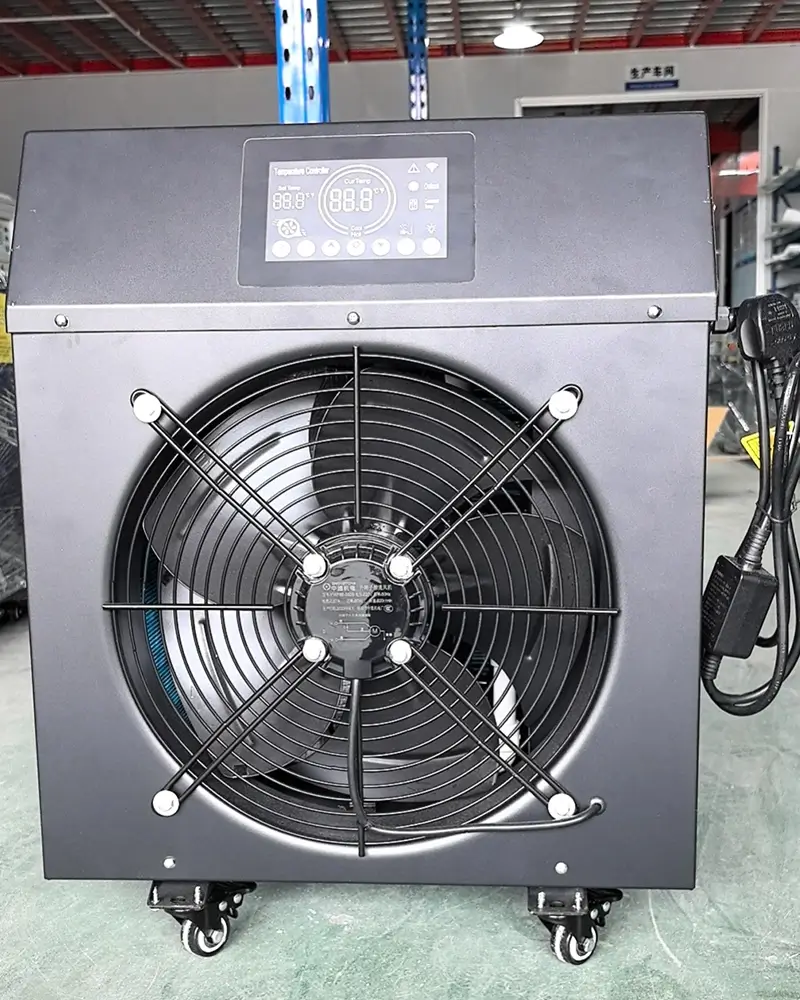Waarom moet water door een koelmachine worden gecirculeerd??
Waarom moet water door een koelmachine worden gecirculeerd??
Water circulation helps to absorb and remove heat generated by the machine, ensuring consistent temperature control and eliminating localized hot spots, which improves heat transfer efficiency and reduces thermal stress on the equipment.
Understanding the importance of water circulation in maintaining water quality and preventing scale and debris buildup can be beneficial. By understanding efficient water flow, you can improve waterkoeler betrouwbaarheid, reduce operational energy consumption, extend equipment life and ensure optimum performance and cost effectiveness.
How does the water cycle prevent the chiller from overheating?
Without ample water circulation, heat would accumulate, causing raised temperature levels that can cause devices to fail or run inefficiently.
Reliable water circulation makes sure that the heat taken in by the water is continually moved away from the equipment to the waterkoeler. The water chiller then dissipates this heat into the setting, frequently making use of a cooling tower or other heat exchange systems. This continual removal of heat maintains the equipment at optimal operating temperatures, thereby preventing the negative effects of overheating.
Bovendien, constant water circulation helps in maintaining a stable temperature around the equipment. Changes in temperature can trigger thermal stress, which can deteriorate materials and components over time. By ensuring a stable flow of water, the water chiller system keeps the temperature within a secure range, thus safeguarding the equipment from damage and prolonging its operational life.
Another vital element is the role of water circulation in removing hotspots. Hotspots are localized areas of high temperature that can create when there is inadequate cooling. These spots can result in unequal thermal expansion, mechanical stress, and possible failure of the equipment. Constant and efficient water circulation helps in dispersing the cooling effect equally across all surfaces, preventing the development of such hotspots.
Why must water be circulated through a chiller?
Water must be circulated through a chiller to absorb and transport heat away from the system. This process is essential for maintaining optimal temperature ranges, improving efficiency, and preventing potential system failures due to overheating.
How does chillers prevent equipment from overheating?
The circulation of water absorbs and removes heat generated by machinery and industrial processes. Without adequate water circulation, heat would accumulate, leading to increased temperatures that can cause equipment to fail or operate inefficiently.
What is the impact of water circulation on energy consumption?
Efficient water circulation directly influences the amount of energy required to maintain optimal cooling performance. By ensuring that water continuously moves through the chiller, heat transfer processes become more effective, reducing the need for the chiller to work harder and consume more energy.
How does water circulation enhance heat transfer and maintain consistent cooling performance in chiller systems?
Effective water circulation ensures consistent and efficient heat transfer from the refrigerant to the cooling medium. This process prevents localized hotspots and maintains uniform temperatures, which are crucial for optimal chiller performance and efficiency. Consistent water circulation also prevents temperature imbalances and thermal stress on system components, ensuring efficient and reliable operation.
Why is water quality important in chiller circulation systems?
Maintaining high-quality water in chiller circulation systems is crucial for preventing issues like scale formation, corrosion, and biological growth. Proper water circulation helps minimize these contaminants, ensuring optimal performance and longevity of the equipment.
How can water quality be maintained in chiller circulation systems?
Maintaining water quality in chiller circulation systems involves using appropriate water treatment methods, such as chemical inhibitors to prevent scale and corrosion, and biocides to control biological growth. Regular monitoring and testing of water parameters, along with routine maintenance like cleaning and flushing the system, are also essential.
Echter, if you choose the Harman N chiller, you can be assured of superior water quality. De Harman N water chiller is equipped with ozone, UV technology, and dual-layer filters, providing an extra layer of protection. This advanced system ensures that you can enjoy your ice bath with complete peace of mind, knowing the water is always clean and safe.
Het bedrijf vóór hem
Waarom moet water door een koelmachine worden gecirculeerd??
Water circulation helps to absorb and remove heat generated by the machine, ensuring consistent temperature control and eliminating localized hot spots, which improves heat transfer efficiency and reduces thermal stress on the equipment.
Understanding the importance of water circulation in maintaining water quality and preventing scale and debris buildup can be beneficial. By understanding efficient water flow, you can improve waterkoeler betrouwbaarheid, reduce operational energy consumption, extend equipment life and ensure optimum performance and cost effectiveness.
How does the water cycle prevent the chiller from overheating?
Without ample water circulation, heat would accumulate, causing raised temperature levels that can cause devices to fail or run inefficiently.
Reliable water circulation makes sure that the heat taken in by the water is continually moved away from the equipment to the waterkoeler. The water chiller then dissipates this heat into the setting, frequently making use of a cooling tower or other heat exchange systems. This continual removal of heat maintains the equipment at optimal operating temperatures, thereby preventing the negative effects of overheating.
Bovendien, constant water circulation helps in maintaining a stable temperature around the equipment. Changes in temperature can trigger thermal stress, which can deteriorate materials and components over time. By ensuring a stable flow of water, the water chiller system keeps the temperature within a secure range, thus safeguarding the equipment from damage and prolonging its operational life.
Another vital element is the role of water circulation in removing hotspots. Hotspots are localized areas of high temperature that can create when there is inadequate cooling. These spots can result in unequal thermal expansion, mechanical stress, and possible failure of the equipment. Constant and efficient water circulation helps in dispersing the cooling effect equally across all surfaces, preventing the development of such hotspots.
Why must water be circulated through a chiller?
Water must be circulated through a chiller to absorb and transport heat away from the system. This process is essential for maintaining optimal temperature ranges, improving efficiency, and preventing potential system failures due to overheating.
How does chillers prevent equipment from overheating?
The circulation of water absorbs and removes heat generated by machinery and industrial processes. Without adequate water circulation, heat would accumulate, leading to increased temperatures that can cause equipment to fail or operate inefficiently.
What is the impact of water circulation on energy consumption?
Efficient water circulation directly influences the amount of energy required to maintain optimal cooling performance. By ensuring that water continuously moves through the chiller, heat transfer processes become more effective, reducing the need for the chiller to work harder and consume more energy.
How does water circulation enhance heat transfer and maintain consistent cooling performance in chiller systems?
Effective water circulation ensures consistent and efficient heat transfer from the refrigerant to the cooling medium. This process prevents localized hotspots and maintains uniform temperatures, which are crucial for optimal chiller performance and efficiency. Consistent water circulation also prevents temperature imbalances and thermal stress on system components, ensuring efficient and reliable operation.
Why is water quality important in chiller circulation systems?
Maintaining high-quality water in chiller circulation systems is crucial for preventing issues like scale formation, corrosion, and biological growth. Proper water circulation helps minimize these contaminants, ensuring optimal performance and longevity of the equipment.
How can water quality be maintained in chiller circulation systems?
Maintaining water quality in chiller circulation systems involves using appropriate water treatment methods, such as chemical inhibitors to prevent scale and corrosion, and biocides to control biological growth. Regular monitoring and testing of water parameters, along with routine maintenance like cleaning and flushing the system, are also essential.
Echter, if you choose the Harman N chiller, you can be assured of superior water quality. De Harman N water chiller is equipped with ozone, UV technology, and dual-layer filters, providing an extra layer of protection. This advanced system ensures that you can enjoy your ice bath with complete peace of mind, knowing the water is always clean and safe.
Over hun auteur

Welkom op onze blog! Mijn naam is Peter en ik ben de hoofdauteur van deze blog. Als sportherstelbeoefenaar en met diepe interesses en expertise.
Ik streef ernaar om complexe concepten op een heldere en bondige manier te presenteren, en lezers in staat stellen die kennis beter te begrijpen en toe te passen door middel van diepgaand onderzoek en het delen van ervaringen.
Bedankt voor het lezen en voor uw steun! Als u vragen of suggesties heeft over de inhoud, Neem dan gerust contact met mij op. Ik kijk ernaar uit om meer interessante en nuttige informatie met u te delen en samen te groeien op deze kennisreis!

